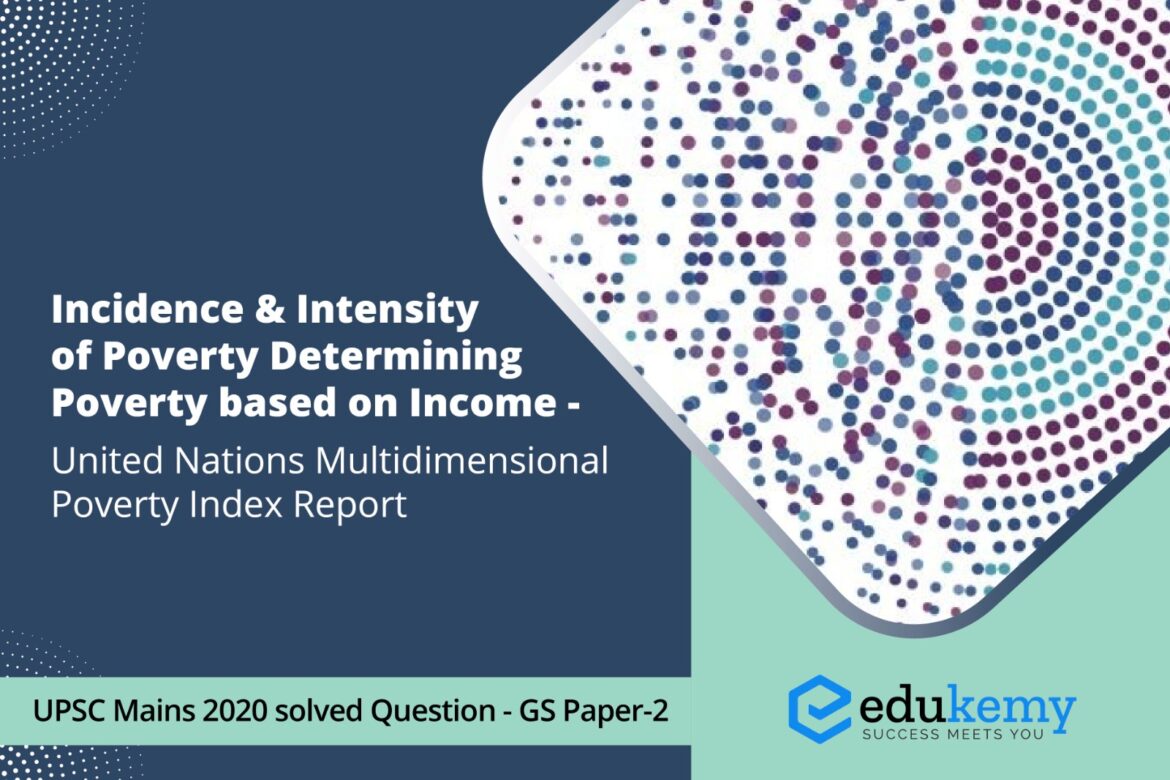
In evaluating poverty, the latest United Nations Multidimensional Poverty Index (MPI) Report underscores the significance of considering both the incidence and intensity of poverty, emphasizing that relying solely on income metrics may be insufficient. The report highlights that understanding poverty requires a nuanced approach that considers various dimensions beyond monetary factors, such as health, education, and living standards. While income-based measurements provide valuable insights, the incidence and intensity of poverty shed light on the depth and breadth of deprivations experienced by individuals. The MPI evaluates poverty by examining overlapping deprivations in these diverse dimensions, offering a more comprehensive view of poverty than income alone. This approach recognizes that individuals can be poor in multiple aspects of their lives, and addressing poverty requires a holistic understanding that goes beyond monetary considerations. By acknowledging the multidimensional nature of poverty, policymakers can better tailor interventions to target specific areas of deprivation, ultimately contributing to more effective poverty alleviation strategies.
UPSC Mains General Studies Paper – 2 Mains 2020
Issues relating to poverty and hunger
UPSC Mains Civil Services IAS Exam Question Paper – 2020
Contents
- 1 Structure of the Question
- 2 Answer
- 3 Conclusion
- 4 Frequently Asked Questions (FAQs)
- 4.1 FAQ 1: What is the United Nations Multidimensional Poverty Index (MPI), and how does it differ from measuring poverty based on income alone?
- 4.2 FAQ 2: How does the MPI capture the incidence of poverty compared to income-based measures?
- 4.3 FAQ 3: Why is the intensity of poverty important in the context of the MPI?
- 4.4 FAQ 4: How does the latest UN MPI Report emphasize the importance of a multidimensional approach to poverty?
- 4.5 FAQ 5: Can the incidence and intensity of poverty based on income alone adequately capture the complexities of poverty as highlighted in the UN MPI Report?
Structure of the Question
- In Introduction,
- Try to define Poverty.
- In Body,
- United Nations Multidimensional Poverty Index Report (MPI).
- Methods to measure Poverty.
- United Nations MPI observation on India’s Poverty.
- Significance of the Report.
- In Conclusion,
- Try to discuss the role of MPI in identification and policymaking to handle poverty issues.
Answer
Introduction
According to the World Bank, poverty is a pronounced deprivation in well-being and comprises many dimensions. It includes low incomes and the inability to acquire the basic goods and services necessary for survival with dignity. In India, the Rangarajan Committee suggested in 2014 that the poverty line is estimated as a monthly per capita expenditure of Rs.1407 in urban areas and Rs.972 in rural areas.
Methods to measure Poverty
The Multidimensional Poverty Index (MPI) integrates two factors of poverty, namely
- the ‘incidence’, which is the percentage of poor people. This is the headcount ratio of multidimensional poverty (H).
- the ‘intensity’ of multidimensional poverty (A) which considers the average percentage of dimensions in which poor people are deprived of three dimensions of poverty- health, education, and standard of living.
- The MPI is calculated as, MPI = H x A (Incidence x Intensity).
UN’s Multidimensional Poverty Index (MPI)
- MPI is based on the idea that poverty does not just depend on income and an individual may lack several basic needs like education, health, etc.
- The UN’s MPI presents quantitative as well as qualitative aspects of poverty. It uses three dimensions viz., Education, Health, and living standard, and gives a score between 0-1.
- According to the MPI Report 2020, around 1.3 billion people are still living in multidimensional poverty.
- In 2019, the burden of multidimensional poverty disproportionately fell on children of the multidimensionally poor who were below 18.
- India was ranked 62nd among 107 countries with an MPI score of 0.123 with a 27.9% headcount.
- The report mentions that India lifted as many as 270 million people out of multidimensional poverty between 2005-06 and 2015-16.
- MPI also reflects that COVID-19 is having a profound impact on the development landscape.
Significance of the report
- Identification of the most vulnerable and the poorest among the poor.
- Revealing the spatial and regional variations.
- Instrumental in targeted policy making and measures by the Government and the NGOs.
Conclusion
The MPI methodology shows aspects in which the poor are deprived and helps to reveal interconnections among those deprivations. Thus enabling policymakers to target resources and design policies more effectively. The MPI methodology can be, and often is, modified to generate national measures of Multidimensional Poverty that reflect local cultural, economic, climatic, and other factors. The best thing about the MPI is that it not only provides a comprehensive and in-depth description of global poverty in all its dimensions but also observes progress towards SDG 1 – to end poverty in all its forms.
Read our Solved Paper.
Frequently Asked Questions (FAQs)
FAQ 1: What is the United Nations Multidimensional Poverty Index (MPI), and how does it differ from measuring poverty based on income alone?
Answer: The United Nations Multidimensional Poverty Index (MPI) is a comprehensive measure that goes beyond income-based assessments of poverty. It considers various dimensions of deprivation, such as education, health, and standard of living. In contrast, measuring poverty based on income alone focuses solely on the economic aspect without accounting for other critical factors affecting people’s well-being.
FAQ 2: How does the MPI capture the incidence of poverty compared to income-based measures?
Answer: The MPI captures the incidence of poverty by assessing multiple deprivations individuals may face. It considers factors like lack of education, inadequate healthcare, and poor living standards. This approach provides a more nuanced understanding of poverty, highlighting the simultaneous presence of multiple disadvantages, which income-based measures might overlook.
FAQ 3: Why is the intensity of poverty important in the context of the MPI?
Answer: The intensity of poverty, or the extent to which individuals experience multiple deprivations, is crucial in the MPI. Unlike income-based measures that may classify individuals as either poor or not, the MPI considers the depth of their poverty by examining the severity and simultaneous nature of deprivations across various dimensions.
FAQ 4: How does the latest UN MPI Report emphasize the importance of a multidimensional approach to poverty?
Answer: The latest UN MPI Report underscores the significance of a multidimensional approach by providing a more holistic understanding of poverty. It not only identifies the percentage of people in poverty but also reveals the intensity and nature of their deprivations. This comprehensive analysis aids policymakers in designing targeted interventions to address specific dimensions of poverty beyond income.
FAQ 5: Can the incidence and intensity of poverty based on income alone adequately capture the complexities of poverty as highlighted in the UN MPI Report?
Answer: The UN MPI Report suggests that relying solely on income-based measures may oversimplify the complexities of poverty. Incidence and intensity, when assessed through a multidimensional lens, offer a more accurate portrayal of the challenges individuals face. Income alone may not reflect the diverse and interconnected factors influencing well-being, emphasizing the need for a broader perspective on poverty assessment.

For UPSC Prelims Resources, Click here
For Daily Updates and Study Material:
Join our Telegram Channel – Edukemy for IAS
- 1. Learn through Videos – here
- 2. Be Exam Ready by Practicing Daily MCQs – here
- 3. Daily Newsletter – Get all your Current Affairs Covered – here
- 4. Mains Answer Writing Practice – here
Visit our YouTube Channel – here

